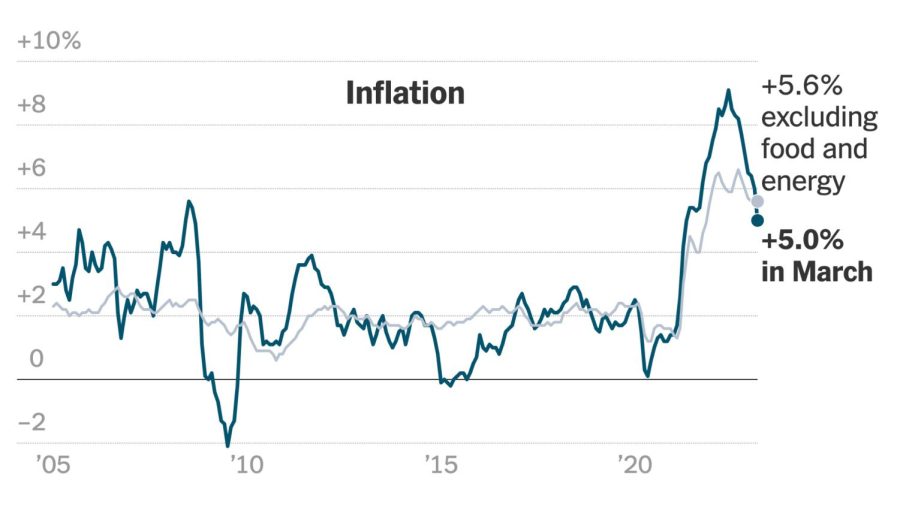March CPI Report Indicates Promise, Remaining Work to be Done
April 17, 2023
On April 12, 2023, the U.S. Bureau of Labor Statistics reported CPI measurements for March. Despite illustrating a generally positive trend, the report, which signified a present chance of future interest rate hikes in 2023, reflected poorly in the market. Two metrics which proved especially notable were Annual Headline CPI and Annual Core CPI. In the past 12 months (ending in March) these metrics have increased by 5% and 5.6% respectively, reaching headlines for, amazingly, opposite reasons.
What is “CPI”?
As defined by the Bureau of Labor Statistics, CPI, or Consumer Price Index, is “a measure of the average change over time in the prices paid by urban consumers for a market basket of consumer goods and services”. Essentially, CPI analyzes the price changes of a variety of goods and services (over a period of time) to forecast the national inflation rate. CPI may also be referred to as “Headline CPI” or “Headline inflation”.
What is “Core CPI”?
Core CPI, much like Headline CPI, assesses a list of price changes across goods and services to calculate the inflation rate. The fundamental difference between the two measurements involves the goods and services included in calculations. Core CPI neglects changes in both food and energy prices due to their inherently greater volatility.
In analyzing inflation, it is important to consider both metrics.
What is the current state of US inflation?
The US headline inflation rate, currently at 5.0%, has been steadily recovering from crises in recent years. Most notably, supply chain disruptions due to the COVID-19 pandemic led to supply shortages (coupled with increased demand as the economy reopened) in 2021, exacerbating CPI through Demand-Pull Inflation. Further, Russia’s invasion of Ukraine in 2022 severely strained the price of food and energy, inducing Cost-Push Inflation. Headline inflation peaked in June of 2022 at a staggering 9.1%, and has since gradually declined. Ultimately, inflation is one of the most pressing economic issues currently.
What is Demand-Pull Inflation?
Demand-Pull Inflation occurs when demand outpaces supply, increasing prices. It may occur due to an increase in any factor which contributes to aggregate expenditure, listed below.
AE = C + I + G + NX
AE = Aggregate Expenditure
C = Consumer/Household spending
I = Investment
G = Government spending
NX = Net Exports (Exports – Imports)
What is Cost-Push Inflation?
Cost-Push inflation occurs when costs of production, such as transportation expenses, increase (generally due to a specific event). Assuming no change in demand, producers pass this increase in price onto consumers.
Analysis:
With regard to Annual Headline CPI, March’s report denotes the single greatest decline in over eight years. In the past twelve months ending in February, Headline CPI was recorded at 6.0%. As stated above, March’s rate decreased by a total percentage point—to 5%. This stark decrease is very much promising, but still leaves inflation well above the Federal Reserve’s target of 2%. In relation to Annual Core CPI, March’s report proves much less positive. In the last twelve months ending in March, Core CPI stands at 5.6%, 0.2% greater than its rate in February. While still worrisome, it is important to note that Core CPI is expected to decrease in the coming months as “shelter costs” decline.
What is the Federal Reserve?
The Federal Reserve is the central bank of the United States. It fulfills a number of purposes including the implementation of monetary policy and regulation of banks. It has established a target inflation rate of 2%.
What to Expect:
The first increase since September of 2022, the current state of Core CPI thoroughly illustrates the necessity (and likelihood) of future contractionary policy. The sharp difference between headline inflation and the Federal Reserve’s target rate further supports this fact. Some experts warn against such policy, citing the potential of a future recession in light of the recent Silicon Valley Bank crisis. Increasing interest rates previous to an impending recession would aggravate said recession, jeopardizing economic stability. The combination of stubbornly high interest rates and a potential future recession leaves the Federal Reserve in a difficult situation. Nonetheless, at least one additional interest rate hike can be expected, but no official announcement will be made until May.
What is monetary policy?
Monetary policy is one of two means by which the supply of money—and thus inflation—is controlled by the government (the other being fiscal policy). Monetary policy can involve open market operations (the purchasing or sale of bonds by the government), the reserve requirement (the required ratio of deposits which banks must retain), and the discount rate (the interest rate charged to private banks by the Federal Reserve). Like Fiscal Policy, Monetary Policy is divided into the two distinct categories of expansionary policy and contractionary policy. Expansionary policy is generally employed during recessionary periods, and involves a loosening of the money supply. Conversely, contractionary policy is usually used during periods of high inflation, and involves a tightening of the money supply.

